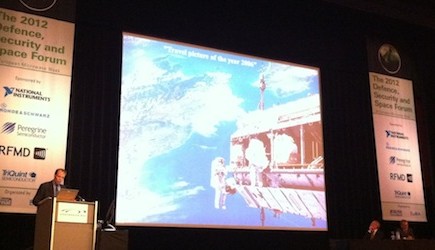Science in Space: Microgravity Experiments Aboard the ISS
November 07, 2012
on
on

Orbiting at the altitude range of 350-400 km, the International Space Station provides a unique opportunity to conduct scientific experiments in a microgravity environment. The data gathered on board the ISS is beamed back to earth and made available to scientists on the ground to advance the knowledge in such fields as human physiology, astrobiology, fundamental physics and technology.
Astronaut and physicist Christer Fuglesang completed two missions to the International Space Station in 2006 en 2009. He gave a keynote speech titled Science & Technology in Space at the Defense, Security and Space Forum, part of the European Microwave Week held in Amsterdam last week.
How to live in space? It is one of the important questions that need to be addressed in preparation of future space exploration missions. To that end human physiology and performance in space are being examined extensively. 'Every system in the body is effected by weightlessness, your muscles weaken, bones demineralize and even how you perceive things is different”, said Fuglesang. “One of the goals of the research is to develop counter-measures to the negative effects of weightlessness.'
Another problem is exposure to high levels of radiation. On earth we’re protected by the shielding effects of the magnetic field. But if humanity would want to go to Mars radiation is a big problem that needs to be dealt with.
To test how terrestrial organisms react to the extreme conditions of space, astronauts placed samples of bacteria, plant seeds and even animals outside the ISS. A fraction of the organisms survived the exposure experiments and revived when they returned to earth. These experiments could be an indication of the validity of the panspermia hypothesis: the idea that life migrates through the universe hitching rides on meteoroids and asteroids.
The ISS also functions as a laboratory for fundamental physics. For instance, some of Einstein’s fundamental principles can be tested more accurately in space. Case in point is the Equivalence Principle, on which Einstein’s theory of General Relativity is founded. 'The Equivalence Principle postulates the equivalence between inertial and gravitational mass or, stated differently, that bodies of different mass and/or composition fall with the same acceleration in a gravitational field’.
Experiments on earth are a factor 106 less precise than those conducted in space due to seismic noise. ‘With these experiments scientists can test the theory of General Relativity and alternative theories of gravitation’, said Fuglesang.
When asked by the audience what his best memory was op his time in space, Fuglesang answered: ‘My best experience was during one of my spacewalks. I was alone in space because my fellow astronaut was working a couple of meters away. I looked down on the ISS and far beyond I could see earth. I was alone but at the same time I was working closely together with the ISS team and hundreds of people on the ground. It was amazing’.
Astronaut and physicist Christer Fuglesang completed two missions to the International Space Station in 2006 en 2009. He gave a keynote speech titled Science & Technology in Space at the Defense, Security and Space Forum, part of the European Microwave Week held in Amsterdam last week.
How to live in space? It is one of the important questions that need to be addressed in preparation of future space exploration missions. To that end human physiology and performance in space are being examined extensively. 'Every system in the body is effected by weightlessness, your muscles weaken, bones demineralize and even how you perceive things is different”, said Fuglesang. “One of the goals of the research is to develop counter-measures to the negative effects of weightlessness.'
Another problem is exposure to high levels of radiation. On earth we’re protected by the shielding effects of the magnetic field. But if humanity would want to go to Mars radiation is a big problem that needs to be dealt with.
To test how terrestrial organisms react to the extreme conditions of space, astronauts placed samples of bacteria, plant seeds and even animals outside the ISS. A fraction of the organisms survived the exposure experiments and revived when they returned to earth. These experiments could be an indication of the validity of the panspermia hypothesis: the idea that life migrates through the universe hitching rides on meteoroids and asteroids.
The ISS also functions as a laboratory for fundamental physics. For instance, some of Einstein’s fundamental principles can be tested more accurately in space. Case in point is the Equivalence Principle, on which Einstein’s theory of General Relativity is founded. 'The Equivalence Principle postulates the equivalence between inertial and gravitational mass or, stated differently, that bodies of different mass and/or composition fall with the same acceleration in a gravitational field’.
Experiments on earth are a factor 106 less precise than those conducted in space due to seismic noise. ‘With these experiments scientists can test the theory of General Relativity and alternative theories of gravitation’, said Fuglesang.
When asked by the audience what his best memory was op his time in space, Fuglesang answered: ‘My best experience was during one of my spacewalks. I was alone in space because my fellow astronaut was working a couple of meters away. I looked down on the ISS and far beyond I could see earth. I was alone but at the same time I was working closely together with the ISS team and hundreds of people on the ground. It was amazing’.
Read full article
Hide full article


Discussion (0 comments)